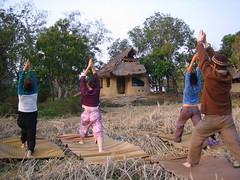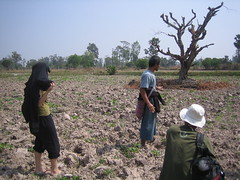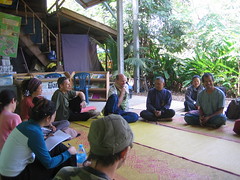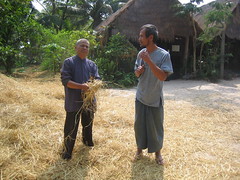Last Economy Standing
Part two in a series of stories from my road trip in Thailand, participating in a study tour hosted by Pun Pun farms, to visit local examples of sustainable living in the Northeast and in Chiengmai.
"So how did you fall so far from the mainstream consumerist path?" I asked Irena on our long bus ride. She told me how she had, as a child, lived on a farm that her family had tried to start, but it was too hard to make a living farming organically.
"Oh so they were part of the back-to-the-land movement," I said. She agreed. We were talking second generation here. Her parents had already chosen an alternative to the consumerist lifestyle.
As I met others on the tour from the youngest college students, including Sasha who was doing her year abroad at Chiengmai University, to the gray haired man in the floral print pants, named Montaine, whom I quickly realized was gay, I would find that each had their own story of how they had veered from the consumerist lifestyle and now found themselves on a similar quest to heal the world through sustainable living practices. The tour was, after all, called simply the Sustainability Tour.
Since we had arrived so late, we got the last two sleeping spaces. I chose to settle on the back porch of one of the larger adobe houses where a pink mosquito net and futon mat awaited me. Martin who was sharing the space with me, reminded me that we had already chatted on the internet when I was searching for a traveling companion. I was comforted by this previous allegiance. He was from Belgium and was the only actual farmer among us. He invited me to share his roll of toilet paper.
At three in the morning I was woken by what sounded like an amplified band of street musicians singing a ballad. It was a mysterious sound that seemed to move as if on the back of a pickup truck, but never came any closer. Having changed time zones by 15 hours, I felt alert and awake and used the time to write. After an hour or so there was the sound of temple bells and then quiet. At dawn I looked through the twin arched windows of the adobe wall and saw the sun rising over a large lily covered pond.
The house, I was staying in, was built along the back edge of a dry rice paddy. I picked my way over the cut brown stalks to the road and walked to the dining pavilion. Just beyond the pavilion, in another rice paddy, we would assemble on mats for a yoga session. This was definitely not Thai—this yoga, on mats, facing another earthen house. This one was more hobbit like with an assortment of asymmetrical windows and a shaggy thatched roof of long dry leaves. The roof was Thai—coconut palms possibly.
At the back corner of the field were Thai people milling about doing chores under a large tin roof, preparing breakfast for us I realized later. I felt them being amused by the funny postures we were assuming. Peggy, the American wife of Jo who owned the farm, was leading a brisk session followed by a brief meditation. Breakfast wasn't exactly Thai either—these boiled yams eaten in a bowl of blue gray soy milk, but eat it I did.
Martin stood beside me making coffee from hot water dispensed from a large insulated thermos. I asked what kind of farming he did. He said picturesquely, "I have man chicken and woman chicken on the same floor and they fertilize the egg, then I sell egg to the hatchery." At every farm we visited he would kneel at the edge of the rice paddy, pick up a handful of soil and sniff it. So I did the same. The soil in this dry landscape was nearly white and did not smell of much in the way of organic matter.
"It's so sandy," I commented to Peggy.
"It's terrible soil," she said laughing.
This is the soil of land cleared of trees. In the 50s, the government had feared that communist insurgents from nearby Laos and Vietnam were hiding in the forest so they had offered the locals titles to the forest land if they promised to clear it and cultivate it. Cash crops ensued and more land was cleared. And, of course, the teak trees were also a cash crop.
The Joys of Subsistent Farming
The region was so dry it only produced one crop of rice a year instead of three, just enough to feed the family with a little left over to sell. This was what we, in the West, call subsistent farming. Jo didn't seem to think there was anything wrong with that. The way he told it this was the land of abundance. Heck, you only had to work for two months of the year to bring the rice in and the rest of the time was your own, he told us. Compare that to 8 hours a day, seven days a week in the congestion and pollution of Bangkok just to make room and board. The land gave you everything you needed. It had taken him seven years to realize this and return to his 9 acre family farm.
In one paddy he had a smorgasbord of vegetables and melons where the seeds had been simply broadcast and tilled into the earth as the cut rice plants were plowed under. This was his green manure crop. He didn't even have to water it because the water lay so close to the earth under that dry sandiness. Okay, if you say so, I thought. I looked at it skeptically, but I knew from my readings on permaculture that the soil was the best place to store water. All you had to do was dig a basin to catch it during the rainy season. These sunken paddies would flood then.
We walked along the dikes that separated one from another. Here and there would be tucked a pineapple plant or a skinny papaya tree. He did have, by the kitchen, what we would recognize as a vegetable garden with leafy greens, irrigated by blue plastic hoses and sprinkler heads. The water was pumped up from a small pond. This, he pointed out was not strictly adhering to the rules of permaculture as it was envisioned by the Australian who had first come up with the permaculture method.
Jo felt that these rules were too inflexible. It was much easier to catch water run-off if the pond was at the bottom of the land rather than at the top. It was true that he then couldn't use gravity to flow the water to where he needed it and had to use an electric pump, but his pond didn't need a liner which was expensive. And there were fish in his pond. They had arrived there during the rainy season as they jumped over the dikes of the rice paddy from other, bigger ponds. He fed the fish with a large mound of straw and cow dung at one side of the pond. As the fish pulled at the straw at the bottom, the mound would slowly slide further into the water. I marveled at this combination of natural phenomena and a little planning and was happy to eat the fried fish cooked up for us.
After hearing the story of Jo's return to the farm, we piled into the back of a large truck with parallel benches facing each other. A canvas roof covered the metal framework arching over the truck bed. This was typical transport for country folk. Middle class Thais in sedans would laugh when they saw all the farangs traveling country style. We hung on to the support posts and shouted our conversation over the noise of the wind and hum of the engine. After some hours we arrived in Ubon Ratchatani, near the Laotian border, where we picked up a couple of late comers. I liked them immediately. They had style and were from Vancouver. Xaaq with his rakish cap of his own design and Alicia who had on black Japanese fisherman's boots and was a hair stylist.
Waking Up From the Dream
We continued to our first stop at Suan Sang Fun an intentional community. The name translated meant "waking from dream". We were warmly greeted by Thais wearing blue farmer jackets and pants and were served a vegetarian lunch that I recognized as Thai plus some added unfamiliar dishes—a creamy corn and rice dish, a tofu paste with spring onions. After we ate we washed our own dishes in a line up of five wash basins; a system I would find everywhere we went.
Assembling on the linoleum in the school area, we listened to a leader of the community speak. His name, Mai Horm, meant aromatic wood. He told us how the community operated by sharing everything and working together. Buddhism was their common bond and each individual was required to follow the five precepts of lay people (as opposed to 8 for monks). These are to refrain from killing, stealing, lying, having sex outside of a committed relationship and to abstain from addictive substances including coffee. Decisions were made by a committee with guidance from monks if no decision could be reached. There was a fund to care for the sick, provide clothes and buy land. Appropriate technology was emphasized and education should add to the knowledge base and pertain to local needs, not be about the Grand Canyon say. We laughed.
"We are fleeing capitalism," he told us as Jo translated, "because capitalism makes slaves of the poor." I am gratified that nobody even flinches at this anti-capitalist statement. No trickle down theorists here. He talks about how they picked simple clothing because it cut down on the social competition and money spent on adornment.
"When you stop competing with society you have more enjoyment of life," he said wisely. Their outfits are all navy blue and look like a regimented uniform. This crossed a line for me. I felt compelled to ask a question.
"People will say that this is communism with a Buddhist twist," I comment. "What is the argument against that?" I ask.
"Maybe they don't need one," says the comely, East Indian, biracial, woman, Jenell, sitting directly across from me. An American, she is a teacher of natural building techniques and has spent much time helping with building projects in Thailand. I look at her, but stand my ground. I need an answer. I haven't suffered the Domino Theory all these years not to ask the communist question. This was, after all, the reason given for the Vietnam War, to protect the whole of Southeast Asia from falling to communism. Jo translates my question.
"This is a voluntary system," said Mai Horm, "communism is a government system that forces people to conform via laws." I mull this over and decide that, because of the Buddhist precepts, this communal entity would not be read as a Marxist threat. The group is, however, associated with a larger movement, the Santi Asoke Buddhist sect founded some 30 years ago by a former popular singer from Bangkok who ordained as a monk. He established some new ideas about an economy based on meritism that did not go down well within the Thai temple system so he formed his own sect.
Last Economy Standing
Meritism is the system of earning brownie points to improve one's spiritual life and, as I learned as a child, to improve ones circumstances in the next life as well. The Santi Asoke group had a set of rules for business that was more gift economy than trade. One's first duty was to feed oneself and family, then the needy in the community. Only then was any surplus sold at below market prices. If a profit was made, it should not be too much. What cash was collected went into improving the community.
They also taught self sufficiency and gave workshops on organic farming and natural health care as well as how to ferment EM (effective microorganisms) for fertilizer and make shampoo and other products that could be sold. A jar full of holes was used to demonstrate what happens when you are trying to pay off debts and are still spending money. You simply aren't able to fill the jar no matter how much water you put in it.
After the economic collapse of 1997-99, those living under the Santi Asoke system were the only group thriving. This got the attention of the Thai government who sent their people to study this economic phenomena. Not wishing any more defaults on loans to farmers from the government supported Farmer's bank, they made it a contingency of any future loans that the recipient train with the Santi Asoke group. Chances were, after they learned the principles of self sufficiency, the farmer would decide he didn't need a loan. And if he still wanted one, his new knowledge was a better guarantee that he would pay off the loan. Since then 100,000 people have taken the training and a quiet movement to self sufficiency was slowly infusing the land.
Labels: economy, Isaan, Thailand, travel, up-country








1 Comments:
I am buoyed by your post today. I'm glad there is a place, though far from here, where sustainability is more than just an interesting concept. Thank you for all the thought you put into your posts: I enjoy reading your work!
Post a Comment
<< Home